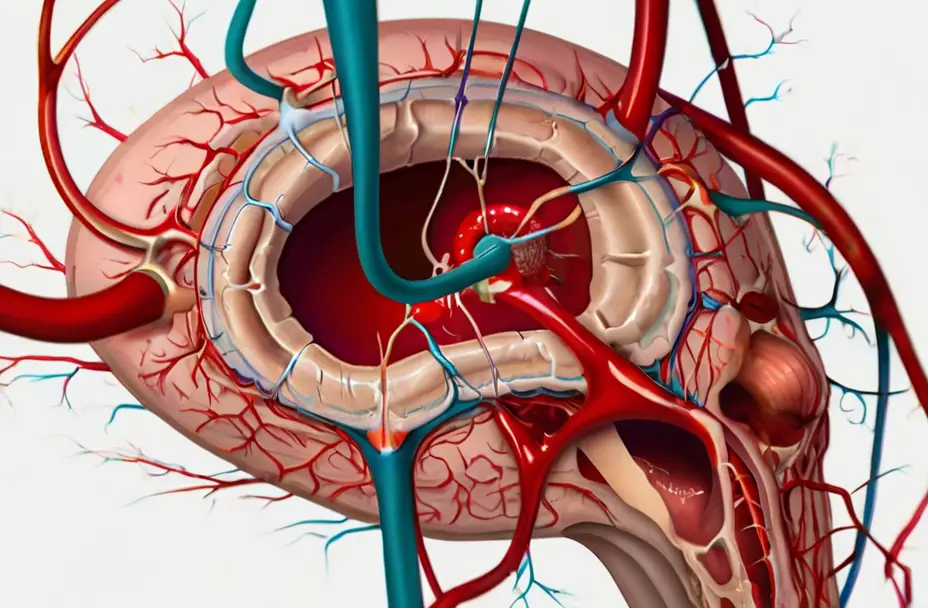
Cerebral aneurysms are a type of medical condition that affects the blood vessels in the brain.
These weakened areas in the blood vessels can potentially rupture and cause severe complications, including stroke or hemorrhage.
In this blog post, we will explore the different types of cerebral aneurysms, their risks, symptoms, and treatment options.
What is a Cerebral Aneurysm
A cerebral aneurysm refers to a weakened section in the wall of a blood vessel located within the brain.
This weakened area poses a risk of rupturing, leading to bleeding inside the brain.
Such bleeding can result in severe complications and even be life-threatening.
- Read also: Cerebellum Damage – Effects And Causes if Your is Cerebellum Damage
- Read also: Understanding Different Types of Cerebral Edema

Different Types of Cerebral Aneurysms
Cerebral aneurysms manifest in various types, each presenting unique characteristics and potential risks.
Understanding these distinctions is crucial for comprehending the diverse nature of this medical condition.
Saccular Aneurysm (Berry Aneurysm)
Picture a small pouch attached to a blood vessel within your brain – that’s a saccular aneurysm, the most prevalent type.
These aneurysms protrude at a weakened spot, resembling a berry clinging to a vine.
Typically, they are located at the base of the brain.
Saccular aneurysms are widespread and constitute the majority of cases.
Fusiform Aneurysm
In contrast to the localized bulge seen in saccular aneurysms, a fusiform aneurysm involves the entire blood vessel wall ballooning outward.
While less frequent than saccular aneurysms, they are often associated with conditions like atherosclerosis, characterized by the buildup of plaque in arteries.
Fusiform aneurysms are less common than saccular ones.
Dissecting Aneurysm
This type occurs when blood dissects or separates layers within the blood vessel wall, leading to a weakening and potential outward bulge.
Although less common, dissecting aneurysms can be serious.
Factors such as head injuries or a buildup of plaque in the arteries can increase the risk.
Dissecting aneurysms are less prevalent compared to saccular aneurysms.
Mycotic Aneurysm
The rarest among cerebral aneurysms, mycotic aneurysms result from a fungal infection that weakens the blood vessel wall.
Individuals with compromised immune systems or those who have undergone medical procedures with a risk of infection are more susceptible.
Mycotic aneurysms are exceptionally rare, accounting for a small percentage of cases.

Risks and Symptoms of Cerebral Aneurysm
Cerebral aneurysms can be ticking time bombs in the brain, but the good news is they often don’t cause problems until they rupture.
However, that doesn’t mean we shouldn’t be aware of the risks and potential warning signs.
Risk factors
- High blood pressure: Uncontrolled hypertension puts constant strain on blood vessels, increasing the risk of aneurysms developing.
- Smoking: Tobacco use damages blood vessel walls and makes them more prone to weakening and ballooning.
- Family history: Having a close relative with a cerebral aneurysm increases your own risk.
- Connective tissue disorders: Conditions like Marfan syndrome can weaken blood vessel walls.
- Age: The risk of aneurysms increases as we age.
- Sex: Women are more prone to aneurysms than men.
Symptoms (especially if sudden and severe)
- Thunderclap headache: This is often described as the worst headache of your life, coming on suddenly and with intense pain.
- Nausea and vomiting: Accompanying the severe headache, nausea and vomiting can be signs of bleeding in the brain.
- Neck stiffness: A stiff neck along with the headache can indicate irritation of the meninges (membranes surrounding the brain) due to bleeding.
- Vision problems: Blurred vision, double vision, or drooping eyelids can occur due to pressure on nerves or bleeding affecting the brain.
- Confusion or loss of consciousness: In severe cases, a ruptured aneurysm can lead to confusion, drowsiness, or even coma.
- Seizures: Seizures may occur due to abnormal electrical activity in the brain caused by bleeding.
- Loss of balance or coordination: Bleeding in the brain can affect coordination and balance.
Different Treatment Options for Cerebral Aneurysms
Cerebral aneurysms might sound daunting, but early detection opens doors to effective treatment options. Here’s an overview of the two main approaches:
Surgical clipping
- Procedure: A craniotomy (surgical opening of the skull) is performed to access the aneurysm. The surgeon meticulously places a small metal clip at the base of the aneurysm, essentially closing it off and preventing blood flow into the bulge.
- Benefits: This is a well-established and highly effective option for aneurysms in accessible locations. Once clipped, the risk of rupture is significantly reduced.
- Considerations: It’s typically reserved for aneurysms with a high risk of rupture or those in locations suitable for clipping.
Endovascular coiling
- Procedure: This minimally invasive technique involves threading a catheter through an artery in the groin or leg and navigating it up to the brain. Tiny coils are then inserted into the aneurysm, causing it to clot and preventing blood flow inside.
- Benefits: This approach offers a less invasive option for some patients, with shorter recovery times compared to surgery.
- Considerations: Coiling might not be suitable for all aneurysms, particularly those with complex shapes. There’s also a small chance the coils could dislodge or fail to completely block the aneurysm, requiring further treatment.

Conclusion
Effectively managing cerebral aneurysms requires a comprehensive understanding of the various types, their associated risks, and available treatment options.
Timely detection and intervention play a pivotal role in preventing severe complications and enhancing overall outcomes.
Familiarizing oneself with this information is key for both medical professionals and individuals seeking to navigate the complexities of this condition.
- Read also: Understanding Cerebral Dysrhythmia
- Read also: A Comprehensive Guide: Cerebral Herniation Symptoms
FAQs
Family history, smoking, high blood pressure, and certain genetic conditions are some of the risk factors.
Diagnosis typically involves a combination of imaging tests, such as CT or MRI scans, and cerebral angiography.
The success rate of treating cerebral aneurysms depends on the size, location, and complexity of the aneurysm, as well as the patient’s overall health and individual factors.


